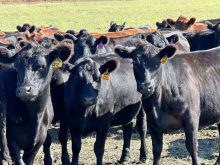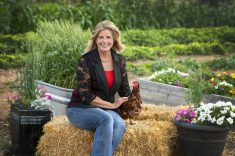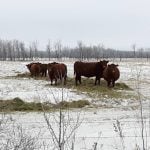The shortage of rural vets is no secret to any livestock producer, but there is fresh hope that may change in the years ahead.
Flush with major new provincial funding, officials at the province’s vet school say they have a plan to address the long-standing problem.
It will start with a slight increase in veterinary students this fall and be followed by a much bigger increase in the next two years along with changes aimed at attracting more young vets and foreign-trained professionals to rural areas.
“We’ll add five more students starting this September, and adding more next year, and the remainder when the new facilities are built in 2024 — we are fast-tracking that,” said University of Calgary president Ed McCauley.
“We’ll be creating a pipeline where our skill and knowledge can grow. Nowhere will this be felt more than in rural Alberta. Soon there will be more students, and soon after that, there will be more vets.
“That is what our agricultural industry needs, and what our province needs.”
Earlier this year, the province pledged $58.5 million for a physical expansion of the university’s vet school and followed that up this month with another $8.4 million over three years to boost enrolment. By 2025, the school will have ‘seats’ for 100 students (double the current 50) — although it will be another four years before they graduate.
The shortage of rural vets has been growing and groups such as the Alberta Veterinary Medical Association have been urging government to act on the problem (which is not just a shortage of vets but also other veterinary professionals).
“There have been some rough days for our profession over the last few years,” said Dr. Natasha Kutryk, the association’s vice-president and a large-animal veterinarian.
“Labour shortages combined with COVID and the rising demand for services have placed tremendous stress on the veterinary profession.”
The vet shortage is a global problem and the boost in provincial funding here will be noticed across the country, she said.
“We have not seen this level of investment in the Alberta veterinary community before,” said Kutryk. “The Canadian veterinary community will take notice of Alberta’s leadership.”
That view was echoed by the dean of the University of Calgary faculty of veterinary medicine.
“I have to congratulate Alberta for taking the initiative here — the rest of Canada is still talking about the problem,” said Dr. Renate Weller.
But addressing the vet shortage will take time, she added.
“We need some short- and medium-term solutions. The whole team at the U of C, we’re running as fast as we can, but we need a few years to produce those new vets for Alberta.”
Part of the solution is to “import some talent,” said Weller, a native of Germany who has worked in the U.S. and U.K. and consulted globally.
“At the U of C, we are ready to help onboard those people,” she said. “We already have plans for micro-credentials so we can assure that those people who come in can fit the market.
Another issue is that most grads from vet schools head towards small-animal practices, usually in urban centres. Only 20 to 30 per cent of U of Calgary grads have gone into a rural practice of any sort.
But Weller said her school plans to address that issue by creating rural and urban “streams.”
“The rural stream will be on large animals,” she said. “However, these people are the true James Herriots (the famous British vet and popular author) — they also need to be able to spay cats or neuter dogs. They need to be rural practitioners who can service all the animals related in those vicinities.”
But to do that, the vet school needs to change, said Weller.
“We have already started changing admission criteria, and we are looking at traits besides academic,” she said.
The school also needs to play a role in supporting grads who go into rural practice, she added.
“I come from a rural area, I’ve worked in a rural area and it’s stressful to be on your own, especially in the cold and dark,” said Weller. “What we are especially going to do and what we are working on is a support network — a tele-support network where we can provide the clinical and personal mentorship that people need.”
Graduating more people willing to go into rural practice won’t work if they don’t stay, she said.
“The shortage is a leaky bucket phenomenon,” she said. “We have true expansion of the sector, but we also have attrition, attrition due to retirement and stress… We also need to keep those professionals in the profession longer, and let them have a fulfilled work life.”
Still, doubling the capacity of the vet school is a major step forward, Kutryk said at a press conference to announce the increased funding for enrolment.
“It has been a dire forecast until today — a day that represents an opportunity, a commitment of educational excellence and dedication to developing a profession that will contribute significantly to the growth and innovation in Alberta’s economy,” she said. “Today is a very good day for the veterinary profession, for Alberta animal owners and for all Alberta children dreaming of one day being a veterinarian.”
















